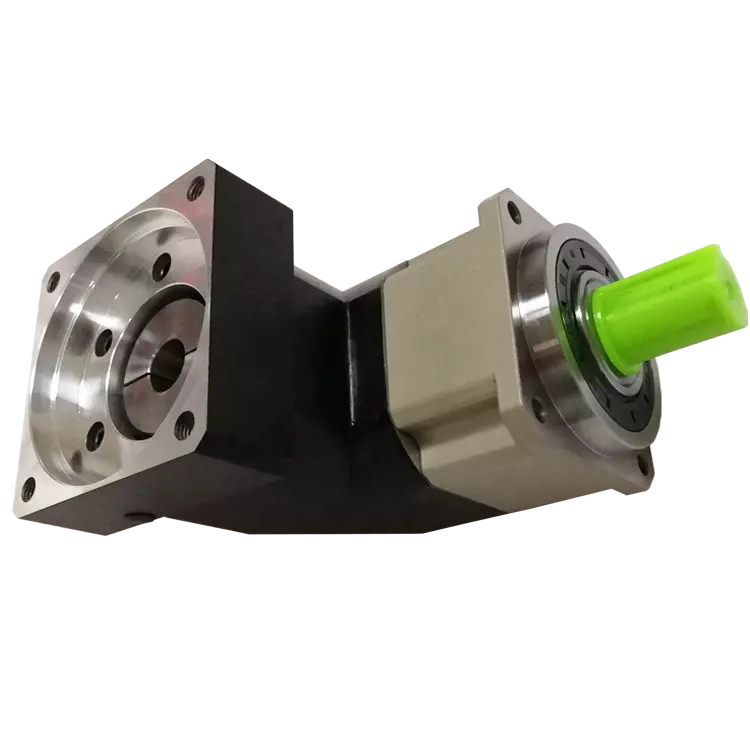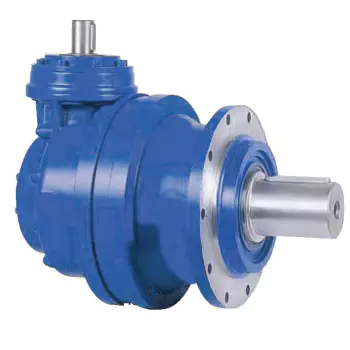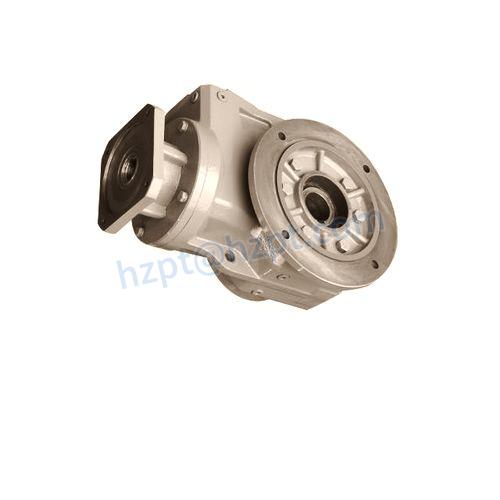Product Description
Product Description
KM050 Aluminium Alloy Right Angle Electric Motor Speed Reducer gearbox
1.KM series Helical-hypoid Gearbox’s Characteristics
KM series helical-hypoid gearbox is a new-generation of product developed by Aokman. With a compromise of advanced technology both at home and abroad, its main features are as follows:
(1) Driven by hypoid gears, which has big ratios.
(2) Large output torque, high efficiency, energy saving and environmental protection.
(3) High-quality aluminum alloy housing, and light in weight and non-rusting.
(4) Smooth in running and low in noise, and can work long time in dreadful conditions.
(5) Good-looking in appearance, durable in service life and small in volume.
(6) Suitable for all round installation, wide application and easy use.
(7) The mounting dimension of KM series helical-hypoid gearbox are compatible with RV series worm gearbox.
(8) Modular and multi-structure can meet the demands of various conditions.
Detailed Photos
2. KM series Helical-hypoid Gearbox’s Main Materials
(1) Housing: die-cast aluminum alloy (frame size 27 to 57)
(2) Gear wheel: 20CrMnTiH1 carbonizing & quenching heat treatment make the hardness of gears surface be up to 56-62 HRC, and be retained carburization layers thickness between 0.3 and 0.5mm after precise grinding.
3. KM series Helical-hypoid Gearbox’s Surface Painting
Aluminum alloy housing:
(1) Shot blasting and special antiseptic treatment on the aluminum alloy surface.
(2) After phosphating, spray the RAL9571 silver white paint.4.Gearbox Parameters
Product Parameters
| Models | Stage | Nominal Ratio | Output Speed (n2)* | Max. Torque | Input Shaft Dia. | Output Hole Dia. | Output Shaft Dia. |
| KM050 | 3 Stage | 50~300 | 4.8~27 | 130N.m | Φ11 | Φ20, Φ24 | Φ25 |
| 2 Stage | 7.5~60 | 24~181 | 130N.m | Φ11 | |||
| KM063 | 3 Stage | 50~300 | 4.6~27 | 200N.m | Φ11 | Φ25, Φ28 | Φ25 |
| 2 Stage | 7.5~60 | 23~184 | 200N.m | Φ14 | |||
| KM075 | 3 Stage | 50~300 | 4.7~28 | 350N.m | Φ14 | Φ28, Φ30, Φ35 | Φ28 |
| 2 Stage | 7.5~60 | 24~187 | 350N.m | Φ16 | |||
| KM090 | 3 Stage | 50~300 | 4.7~28 | 500N.m | Φ14 | Φ35, Φ38 | Φ35 |
| 2 Stage | 7.5~60 | 24~187 | 500N.m | Φ19 | |||
| KM110 | 3 Stage | 50~300 | 4.7~27 | 750N.m | Φ19 | Φ40, Φ42 | Φ42 |
| 2 Stage | 7.5~60 | 24~187 | 750N.m | Φ24 |
Packaging & Shipping
Company Profile
Our Advantages
After Sales Service
| Pre-sale services | 1. Select equipment model. |
| 2.Design and manufacture products according to clients’ special requirement. | |
| 3.Train technical personal for clients | |
| Services during selling | 1.Pre-check and accept products ahead of delivery. |
| 2. Help clients to draft solving plans. | |
| After-sale services | 1.Assist clients to prepare for the first construction scheme. |
| 2. Train the first-line operators. | |
| 3.Take initiative to eliminate the trouble rapidly. | |
| 4. Provide technical exchanging. |
FAQ
1.Q:What kinds of gearbox can you produce for us?
A:Main products of our company: UDL series speed variator,RV series worm gear reducer, ATA series shaft mounted gearbox, X,B series gear reducer,
P series planetary gearbox and R, S, K, and F series helical-tooth reducer, more
than 1 hundred models and thousands of specifications
2.Q:Can you make as per custom drawing?
A: Yes, we offer customized service for customers.
3.Q:What is your terms of payment ?
A: 30% Advance payment by T/T after signing the contract.70% before delivery
4.Q:What is your MOQ?
A: 1 Set
If you have any demand for our products please feel free to contact me. /* January 22, 2571 19:08:37 */!function(){function s(e,r){var a,o={};try{e&&e.split(“,”).forEach(function(e,t){e&&(a=e.match(/(.*?):(.*)$/))&&1
| Application: | Motor, Machinery |
|---|---|
| Function: | Speed Changing, Speed Reduction |
| Layout: | Orthogonal |
| Hardness: | Hardened Tooth Surface |
| Installation: | Industry |
| Step: | Double or Three-Step |
| Customization: |
Available
| Customized Request |
|---|

Disadvantages and Limitations of Angle Gearbox Systems
While angle gearbox systems offer numerous advantages, there are also some disadvantages and limitations to consider:
- Complex Design: Angle gearboxes can have a more complex design compared to standard gearboxes, which can make them harder to manufacture, assemble, and maintain. This complexity can also lead to higher production costs.
- Efficiency Loss: Due to the multiple gear stages and changes in direction of motion, angle gearboxes can experience higher friction and efficiency losses compared to straight-line gearboxes. This can result in some energy loss and heat generation.
- Space Constraints: The design of angle gearboxes often requires more space to accommodate the multiple gear stages and components, which can be a limitation in applications with limited space.
- Increased Maintenance: The complex design of angle gearboxes can lead to increased maintenance requirements. Components such as bearings, seals, and gears may need more frequent inspections and replacements.
- Cost: Angle gearboxes can be more expensive to produce and maintain due to their intricate design and the precision required in manufacturing. This can impact the overall cost of the machinery or equipment in which they are used.
Despite these limitations, angle gearbox systems are chosen when their benefits outweigh their drawbacks for specific applications. Engineers and designers carefully assess the requirements of the application to determine if an angle gearbox is the optimal solution, taking into account factors such as space availability, load demands, efficiency considerations, and budget constraints.

Usage of Angle Gearboxes in Right-Angle and Bevel Gear Applications
Angle gearboxes are versatile components that can be effectively used for both right-angle and bevel gear applications. Here’s how they are utilized in each context:
Right-Angle Applications: Angle gearboxes are commonly used in right-angle applications where there is a need to transmit motion at a 90-degree angle. They efficiently change the direction of rotational motion without the need for additional components or complex mechanical arrangements. This makes them suitable for various industrial machinery, conveyors, and equipment where space constraints and changes in motion direction are important considerations.
Bevel Gear Applications: Angle gearboxes are also employed in bevel gear applications. Bevel gears are used to transmit motion between intersecting shafts, and angle gearboxes with bevel gears are designed to handle this type of motion transmission. They can efficiently transfer motion and torque between shafts that are not parallel, enabling smooth power transmission even when the input and output shafts are at an angle other than 90 degrees.
Whether it’s changing the direction of motion in right-angle applications or facilitating motion transmission between non-parallel shafts in bevel gear applications, angle gearboxes play a crucial role in ensuring efficient and reliable mechanical operations.

Contribution of Angle Gearboxes to Changing Rotational Direction
Angle gearboxes, also known as bevel gearboxes, play a significant role in altering the direction of rotational motion in mechanical systems. They achieve this by utilizing specially designed bevel gears that have their teeth cut at an angle, typically 90 degrees. This angled configuration allows the gears to mesh smoothly while transmitting power between intersecting shafts at different angles.
Here’s how angle gearboxes contribute to changing the direction of rotational motion:
- Meshing of Bevel Gears: Angle gearboxes consist of two bevel gears with intersecting shafts. The gears have teeth that are cut in a way that enables them to mesh together when the shafts are at an angle, usually perpendicular to each other.
- Transfer of Torque: When one bevel gear receives rotational input from a source, it transmits torque to the second bevel gear through the meshing of their teeth. This transfer of torque allows power to be transmitted from one shaft to the other.
- Change in Direction: As the first bevel gear rotates, it drives the second bevel gear to rotate in a direction that is perpendicular to the input shaft. This change in direction of rotation is a fundamental function of angle gearboxes.
- Multiple Configurations: Angle gearboxes come in various configurations to accommodate different angles between shafts, including right angle (90 degrees), acute angles, and obtuse angles. This versatility allows them to adapt to diverse applications.
Angle gearboxes are crucial components in mechanical systems where the input and output shafts need to be oriented at different angles. Their ability to smoothly change the direction of rotational motion makes them valuable in a wide range of industries and applications.


editor by CX 2024-04-10
